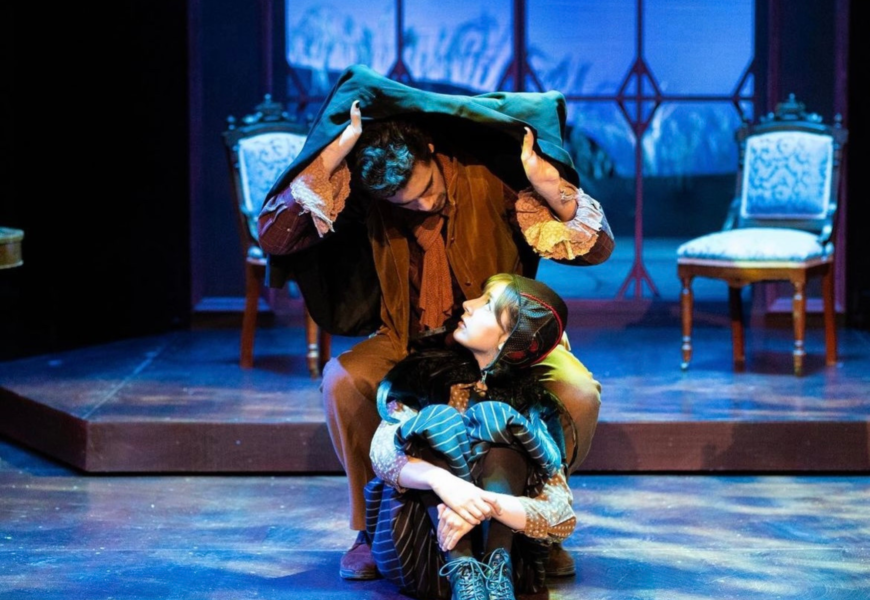Photo Courtesy of @conncolltheater on Instagram
The Moors, the Connecticut College Theater Department’s mainstage play, took place the weekend of Nov. 18 in Tansill Theater. As a passionate lover of the sardonically funny and the macabre, I can say wholeheartedly that The Moors is one of the best plays I have had the pleasure of seeing. It beautifully toes the line between the comedic and the twisted, featuring a tragic love story between a dog and a bird, a maid who is simultaneously three different women, all vying for power, and a climactic murder ballad performed by a woman covered in her sister’s blood. The Moors is explosive; its characters constantly push against the constraints set for them by the barren landscape, and even through such a temporal distance, it remains ever so grounded in issues we see in our 21st century world.
As I was the dramaturg for this production, I was given the opportunity to become very well acquainted with the play. By the end of its run, I had probably read the entirety of the script close to five times, and I managed to fall even more in love with it every time. Written by playwright Jen Silverman in 2017, The Moors tells the story of two sisters, Agatha and Huldey, their maid, and the new governess. Tensions arise between the four women as their goals and ambitions begin to conflict, alliances – even romances – form, and the desire for domination results in more than one character meeting a bloody end. Since first reading the script, I have been entranced by Silverman’s writing, each character seeming so fully realized. Throughout The Moors, Silverman beautifully balances moments of levity and humor with the underlying darkness of the gothic genre. Each decision made by the characters is thoroughly thought out, nothing present without a purpose.
With lines such as “God loves women. On their knees. Scrubbing,” “This isn’t gravity, this is love,” and “There is nothing in this world more honest and dependable than self-interest,” Silverman’s words linger in audience’s minds long after they are spoken; this is made even more true by those speaking the words. The Moors featured Brielle Blood ‘24 as Agatha, the stern, conniving lady of the house, Amanda Brady ‘25 as Huldey, Agatha’s flighty younger sister with ambitions of fame, Nadia Hopkins ‘25 as Marjory – possibly even Mallory or Margaret – the house’s dour maid with a desire for control, and Sophie Bianchi ‘26 as Emilie, a new governess who has been summoned to the house under dubious circumstances. These four women all inhabit one house which steadily grows more and more cramped by their warring desires and ambitions.
Rounding out the cast by playing the only non-human characters were Lucas Vasquez ‘25 and Ava Mary Aloia ‘26 as the Mastiff and the Moor-Hen. Vasquez perfectly channeled the Mastiff’s melancholy yearning for companionship, and Aloia complemented such desperation perfectly with the Moor-Hen’s grounded humor and plain-faced understanding of the world. Together, they were able to keep the audience engaged in the tragic romance between their characters, understanding why it had to end this way but still wishing for something better. The tragic love between the Mastiff and the Moor-Hen is never once played as a joke, the audience only laughing when the Mastiff mistakes the Moor-Hen for God. In fact, this storyline is likely the most realistic part of the play, carefully illustrating the relationship’s descent into its violent end.
At the darkest core of the show are Agatha and Emilie. Having taken drastic measures to prevent her older brother from causing any more messes that she would have to clean up, Agatha has summoned Emilie in order to guarantee that her family will be a lasting one, with Agatha at its head. Blood portrays Agatha with a steely core, an unwavering refusal to bend to anyone’s will but her own. Yet, over the course of the play, as she grows closer to Emile, who reveals herself to be far less naive than she initially appears, Agatha seems to soften, allowing herself moments of vulnerability at Emilie’s hands as the play approaches its climactic conclusion. Despite her abrasive personality, the audience cannot help but root for Agatha as she reveals the desperation for some level of control that drove her to make her choices, even as she meets an untimely end. Bianchi, on the other hand, gently leads Emilie through what is almost the opposite character arc of Agatha’s. She convincingly peels back Emilie’s layers, revealing her to be far more than a naive young governess; she is instead growing into the new lady of the household, determined to keep her position.
Despite leaning into the dark, twisted nature of the gothic genre, The Moors does not shy away from absurdity. With a primary storyline being a romance between a dog and a bird, such an avoidance would do the show a disservice. But instead, both the script and the actors committed wholly to the comedic aspects of the story, simultaneously in on the joke with the audience, but believing in their character and their words entirely. In her portrayal of Huldey, Brady never once let the audience believe that she thought herself to be a joke. Huldey was entirely committed to her melodramatic ways, not behaving that way in order to elicit laughter, but because that was simply who her character was.
Also carrying much of the humor of the show – though in a much more biting way – was Marjory (among other names). Hopkins’ Marjory was conniving, constantly looking for a way to slip out from Agatha’s controlling watch. She may not read as the most comedic character, but her intense, unblinking stare, blunt words and complete determination to put Emilie in her place consistently elicited laughter from the audience. Hopkins’ unflinching portrayal of Marjory and commitment to Marjory’s habit of – quite literally – creeping around the periphery of the stage gave the character the perfect touch to pair the unsettling with the comedic.
Even through the humor of the show, The Moors has an unbelievably strong core, wrestling with questions of gender, power, and class, and the actions that count as unwarranted cruelty with limited options. Professor Ken Prestininzi’s direction gave the audience no opportunity to flinch away from the action, bringing the actors right into their faces. The audience was barely given a chance to look away, to ignore the unspeakable violence that occurred in the story through the removal of choice, of agency, of power from the lives of the characters. Although it may seem as if The Moors has a somewhat tragic end, it can also be seen as a victory for Emilie and Marjory, the two women left standing in the wreckage at the end, as they have finally been given the power they so desperately craved, leaving the audience to wonder about the nature of power, and what one must do to get it.










